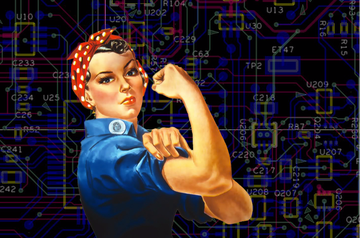Did you know? Computer Programming Started Off As Women’s Job
If statistics and the thousands of engineering classroom jokes are to be believed, computer programming in the modern day is something that more men tend to opt for, as compared to women. But did you know that when it first started off, it was a “woman’s job.”
Let’s take the example of Jean Jennings Bartik, who like a lot of women in the 1930s had studied mathematics. She was also among the group of women who actually worked as a “computer” during and after World War II.
They calculated by hand the trajectories of military rockets and artillery shells depending on how much soldiers elevated the weapon, each calculation of which, took more than 30 hours.
In 1945, Bartik heard about a new job, working with ENIAC. ENIAC was the first large-scale electronic computer who could do the trajectory calculations much faster. Men designed it but the women took up the gruelling and tedious task of creating programs for it. Women were (are) very good at math but their work was unglamorous and low-paid.
The night before the public launch of ENIAC, it was malfunctioning. Bartik and her colleague Betty Jennings got it working. At the demonstration, ENIAC did the trajectory calculation in 20 seconds—10 seconds less than it would take the actual shell to reach its target.
It left the audience spell-bound but Bartik and Jennings were not mentioned once in the press coverage. Their work never got the spotlight.
After the end of the war, Bartik and her six-woman team of “ENIAC Girls” went to work with the UNIVAC, one of the first commercial computers. There they met Navy Reservist Grace Hopper, who was looking for a way to make it easier to program computers with instructions.
Entering reams of numbers was complicated and not very intuitive. She discovered a method of programming a computer with words instead of numbers, and created a programming language that basically allowed operators to give the computer commands in English.
This language was called COBOL. COBOL is still widely used today, in almost all business transactions, even those as everyday as swiping a credit card.
Between 30 and 50 percent of programmers were women in the 1950s, and it was seen as a natural career for them. “It’s just like planning a dinner…You have to plan ahead and schedule everything so that it’s ready when you need it,” Dr. Hopper said. “Women are ‘naturals’ at computer programming.”
But by now the dynamics had begun to change. Programming was no longer clerical work but intellectually strenuous. With salaries rising, more men began to take interest in it and sought to increase their own prestige.
Hiring of women began to be discouraged. Programming started being compared to more masculine activities like playing chess. Ad campaigns criticized women as gossiping, time-wasting, and error-prone.
An ad for Optical Scanning Corporation Ran had the tagline, “What has sixteen legs, eight waggly tongues and costs you at least $40,000 a year?” Your team of 8 female programmers, that’s what.”
HR managers’ personality tests revealed that an important trait of programmers was being anti-social – a trait associated with men.
With the dawn of the age of personal computers in the 1980s and the rise of Steve Jobs and Bill Gates, this stereotype was further strengthened. As video games could be played on personal computers, advertisers marketed them only to men and boys.
Families were far more likely to buy computers for boys than girls. And since college admissions officers expected computer science applicants to have experience with home computers, women were less likely to be accepted.
Admissions also relied on the stereotype of programmer as male nerd, says Virginia Tech professor Janet Abbate. A teenage boy who was in the computer club in high school was more likely to fit the bill than a girl who liked maths.
By 2011, the percentage of women in computer science programs had fallen to 17%. Today, just 6.7% of women get a degree in science, technology, engineering or math, compared to 17% of men.
The male-washing of the programming industry is a lot like filmmaking. Screenwriting and editing were women’s work. Then, as the Hollywood studio system made those jobs far more lucrative, they became men’s work.
















